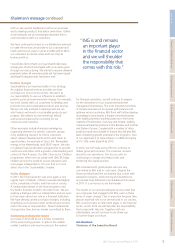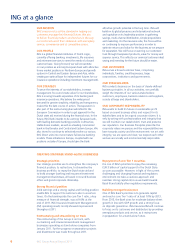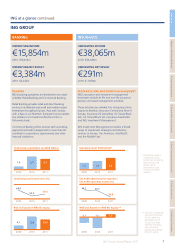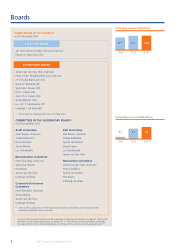ING Direct 2011 Annual Report Download - page 17
Download and view the complete annual report
Please find page 17 of the 2011 ING Direct annual report below. You can navigate through the pages in the report by either clicking on the pages listed below, or by using the keyword search tool below to find specific information within the annual report.
1 Who we are 2 Report of the Executive Board 3 Corporate governance 4 Consolidated annual accounts 5 Parent company annual accounts 6 Other information 7 Additional information
of consumers by pooling their long-term risks and providing
guarantees at affordable prices. Through the accumulation
ofpremiums, insurance companies are also major institutional
investors that provide long-term funding to companies and
institutions via the capital markets. By spreading risks and
extending long-term funding, the insurance industry thereby
alsoplays an invaluable role for society as a whole in dampening
volatility through economic cycles.
In order to achieve these goals it is very important that the Solvency
II framework, as originally envisaged, will become market-based,
avoids pro-cyclicality and should be able to withstand market
volatility. The framework should therefore ensure that the measures
to be implemented are robust enough throughout market cycles.
Moreover, there needs to be a balance between on the one hand
pricing that is affordable and on the other hand meeting capital
objectives with which the industry can fulfil its long-term
obligations. Such a balanced market-based framework should be
designed to last for a long time (to come) and should maintain the
ongoing trust from consumers, thereby positioning the European
insurance industry for the future.
ING wants to work constructively with its colleagues in the
insurance industry to advise EU policy makers and regulators to
come up with concrete proposals to meet these objectives. It is
important that the framework is built to last and will service society
as a whole for a long time to come.
In March 2011, the European Insurance and Occupational Pensions
Authority (EIOPA) published the results of its Fifth Quantitative
Impact Study (QIS5) on Solvency II. ING participated in QIS5
independently as ING Insurance, and also as ING Group, which is in
line with our internal preparations to become fully Solvency
II-ready. Based on the results, EIOPA and the Dutch central bank
confirmed that the financial positions of European and Dutch
insurers remained sound. Individual results were not disclosed.
The results have been fed into the European Commission’s process
for fine-tuning the Solvency II framework and implementation.
ALIGNMENT OF REMUNERATION POLICIES WITH CRD III
Since the start of the crisis in 2008, ING has been continually
reviewing and amending its remuneration policies in response
tothe ongoing review of the financial system and related public
debate, as well as in line with applicable regulatory developments.
In 2010, the European Commission issued the Capital Requirements
Directive III (CRD III), which contained specific requirements in relation
to the remuneration of those who have a material impact on the
company’s risk profile, the so-called Identified Staff. From 1January
2011, the directive had to be implemented into national law.
In 2011, ING’s remuneration policies for the Executive Board and
Identified Staff were amended in line with the CRD III requirements.
The amended policy for the Executive Board was adopted by the
annual General Meeting of Shareholders in May 2011. Our
remuneration policies continue to have an increased focus on
long-term value creation, risk and non-financial performance
measures to improve sustainable business practices.
ING’S APPEAL AGAINST THE EC DECISION
In January 2010, ING filed an appeal with the General Court of
theEuropean Union against specific elements of the European
Commission’s decision of 18 November 2009 which approved the
state aid received and ING’s restructuring plan. ING requested the
Court to annul the decision of the European Commission insofar:
• as it states that the agreement between ING and the Dutch
State concerning a reduction of the repayment premium for
thefirst EUR 5 billion tranche of core Tier 1 securities leads to
additional state aid of EUR 2 billion;
• as the Commission has subjected the approval of the state aid
tothe acceptance of price leadership bans; and
• as the Commission has subjected the approval of the state aid to
restructuring requirements that go beyond what is proportionate.
The Dutch State joined ING in 2010 in its appeal with the General
Court to contest the EC decision insofar as it qualifies the core
Tier1 amendment as additional state aid. The Dutch central bank
joined the proceedings in support of ING’s appeal. In July 2011, oral
arguments of the appeal case were heard by the Court. The ruling
of the Court was on 2 March 2012. ING welcomes the judgment to
partially annul the EC decision. From 2 March, ING has been in the
process of carefully assessing the full judgment as well as its
consequences.
15ING Group Annual Report 2011
Financial and regulatory environment continued
























